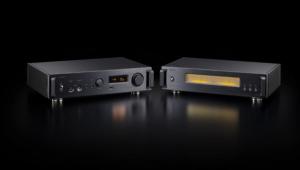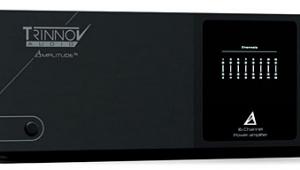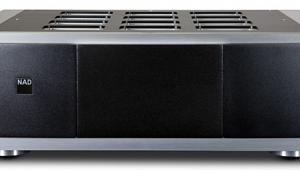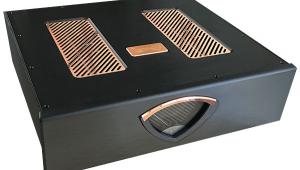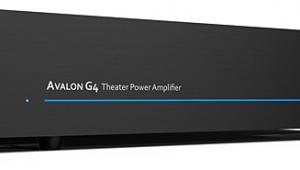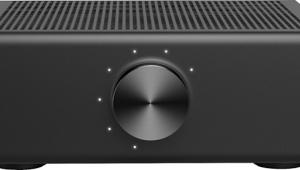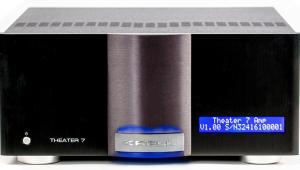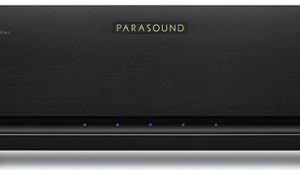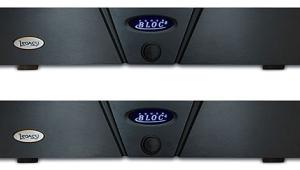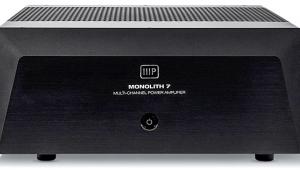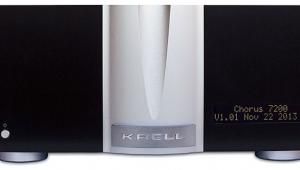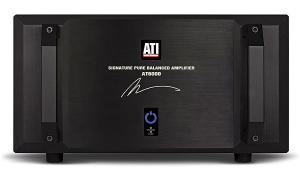Krell Home Theater Standard 2 & Theater Amplifier Standard pre-pro and 5-channel amp Page 3
The Krell Theater Amplifier Standard TAS is a 5-channel amplifier of average Krell dimensions and build quality—in other words, it's big, heavy, and bulletproof. "Beautiful" also comes to mind. The huge Power/Standby switch announces itself even when the amp is off. When the amp is on, a very visible cornflower-blue halo surrounds the button. Its glow, especially in a darkened room, reminded me very much of the alien navels in the opening scene of The Fifth Element. Maybe I've been to one home-theater demo too many.
 The top of the Krell is perforated with lots of heat-releasing slots. Although the amp throws off a lot of heat, it doesn't get dangerously hot. Still, I wouldn't recommend shutting it up in any closed-door cabinet that didn't also dispense ice. Krell recommends at least 2 inches of side clearance (which rules out standard 19-inch-wide racks unless they're open on the sides) and 2 inches of top clearance, but I'd give the TAS a bit more headroom.
The top of the Krell is perforated with lots of heat-releasing slots. Although the amp throws off a lot of heat, it doesn't get dangerously hot. Still, I wouldn't recommend shutting it up in any closed-door cabinet that didn't also dispense ice. Krell recommends at least 2 inches of side clearance (which rules out standard 19-inch-wide racks unless they're open on the sides) and 2 inches of top clearance, but I'd give the TAS a bit more headroom.
The unit's true power switch, more akin in form and function to a circuit breaker, is also on the rear panel. The button on the front panel merely throws the TAS into Standby, greatly reducing energy requirements while continuing to feed a trickle of current to critical circuits. The heavy-duty speaker terminals accept bare wire, pins, or what I used: spades. Although the Krell's speaker terminals are the plastic hex-nut variety, the underlying hardware is gold-plated and very heavy-duty, allowing me to really tighten down with my post wrench.
Each of the TAS' five channels is capable of outputting 200W into 8ohms or 400W into 4ohms. Krell recommends a dedicated 20-amp circuit, and it's easy to see why. The very heavy and non-detachable power cord says it all—this baby needs to eat! Internal settings allow you to bridge the first two or last two channels or both, giving you 800W of power into 8ohms to each of the resulting bridged channels. (Krell doesn't recommend bridging with speakers rated below 4ohms.)
Krellistic Sound
The TAS had no trouble driving my MartinLogan Prodigy/Theater/ReQuest system in either 2- or 5-channel mode. The impedance of these speakers can dip as low as 1ohms—ample proof of the Krell's ability to drive severe loads. I also hooked up my longtime reference speakers, the Alón by Acarian Systems Point Vs, to hear what the Krell sounded like from the dynamic side of the speaker divide.
I hope I'm not in the minority when I say I spend a lot of time listening to music. Music is an important ingredient in my home-"theater"-cum-family-room, and I hope it is in yours. I could never settle for a power amp that was good for movies but only so-so for music. Krell built its reputation on churning out great music through monoblock and stereo amps, and the TAS is cut from the same cloth.
The Krell was very detailed. A classic like Jimi Hendrix's remastered Are You Experienced CD (MCA MCAD-11602) offered up all its secrets. It was easy to hear the layers of feedback Hendrix used to simulate weirdness in "Third Stone from the Sun," the deep phasey echoes applied to whispered voices in "Foxy Lady," and that in-your-room live sound Jimi pulled out for "Hey Joe." The soundstage, intentionally manipulated by Hendrix, held more surprises. His voice on "Third Stone" floated about a foot above the Alóns and a few feet to the outside of the left speaker, seeming to come from the temporarily idle MartinLogan speaker perched protectively to its side.
The TAS managed to draw out some very fine, detailed bass from the diminutive Alóns. Even if you use a subwoofer for movies, most surround processors will let you take the Krell's bass out for a stretch by driving your main speakers full-range in stereo mode. The Krell's control of the MartinLogan Prodigys' bass was gentle, not brutish—very textured and harmonically correct instead of simply harmonically rich.
The Krell's ultimate power delivery went beyond even the MartinLogan Prodigys' ability to receive. Like a Midget football team with a star quarterback, the Krell could throw passes few could receive. A sharp snapping noise awaited me at 18:50 into Enemy at the Gates as Jude Law's character attempts to cover his sniper shots by timing them to coincide with exploding bombs. The MartinLogans weren't expecting the Krell's onslaught—their Mylar drivers were clearly hitting the stators. Properly recorded, gunfire and explosions contain severe transient peaks. (For just that reason, Telarc has for years printed sternly worded warnings on their demo CDs that include gunshots.) Krell claims the TAS will deliver 400Wpc into the Prodigy's near-4ohms load, and I have to believe it—the TAS didn't hesitate for even a split second before driving the speakers full force. The only solution was to turn the volume down.
The DTS soundtrack of Almost Famous is full of the songs I grew up on. Writer-director Cameron Crowe introduces two of them—"America" (Simon and Garfunkle) and "Sparks" (The Who)—by having a character in the film drop the needle in the groove. What comes out first sounds like an actual record playing on a record player and being picked up by set mikes. The music then skillfully blooms into the full-range, room-enveloping dramas that can be created only in the editing process. The TAS never lost its breath as the sound migrated and grew, exponentially and emotionally.
Other details kept popping out, many of them subtle but no less important. The closing credits of Almost Famous feature the Beach Boys' "Feel Flows" (from Surf's Up), no doubt from a digitally prepared master. But very quietly superimposed on the song are some vinyl clicking and low-frequency groove whoosh—things I hadn't noticed until the Krell exposed them. (At the end of the credits you can hear the telltale sound of an automatic record player lifting its tonearm and turning itself off.) Even more delicate and vividly realistic is the sound of a live band as heard from the parking lot outside the stadium in which it's playing. The aural clues, from thumping but indistinct bass to the crunchy lead guitar, populate a space seemingly outside the viewer's perception but still manifest enough to excite the viewer for whatever comes next. Credit Crowe, of course, but kredit Krell as well—the TAS was clearly capable of simultaneously maintaining and delineating these different sonic layers to convey multiple sonic realities.
A great example of a soundtrack with real depth is that of Twelve Monkeys. Accordions, PA systems, and an underground world of the future in which leaky pipes constantly drip (this seems to be mandatory for any future underground world) all make for a colorful, intricate soundstage. The Krell brought out all of these details and successfully contributed to re-creating director Terry Gilliam's nightmare world. The TAS was very quiet, exuding the breathless silence of a large, overdamped movie theater, and its huge dynamic range was obvious at all times. From the quietest moments—of which there are many in this movie—to the bombast of World War I, the TAS responded beautifully.
Tonally, the Krell was neutral, leaning away from "romantic" while remaining lush. Music was clean and involving, but harsh soundtracks got no slack. Unlike the Sunfire Cinema Grand Signature, with which I'm very familiar and comfortable, the Krell could be unforgiving. The best recordings, however, were rewarded with a natural timbre that left little to be desired. James Taylor's DVD Live at the Beacon Theatre has both 5.1-channel Dolby Digital and 24-bit/48kHz PCM soundtracks. Both sound superb, the 5.1 track succeeding in re-creating a room-filling sense of the original venue. The real treat, though, is the transient crispness of the more direct-sounding 2-channel PCM track. The 5.1 track is softer by comparison, missing a hair of the PCM track's leading edge. Taylor's acoustic guitar, in particular, rings with the sharper, unhomogenized grit of a real guitar on the PCM track. The Krell easily pointed out these differences.
Balanced and Unbalanced Konklusions
The Krell Home Theater Standard 2 and Theater Amplifier Standard are Krell's multichannel statement products. Bug-free operation, ergonomic success, and sonic excellence are exactly what I expected from the Home Theater Standard 2. I was not disappointed. And the Theater Amplifier Standard was everything I expected from a Krell amp: accurate, detailed, powerful, and well-built.
But if there is one term this Freddie Soprano should have associated with "Krell" in his 50 minutes with Dr. Melfi, it's "high-end." Krell is to high-end audio what Gibson is to guitars and Porsche is to racing. Cosmetics should not mean much beyond pride of ownership, but here again, the Krells are beauties by any definition. They live up to their name.
- Log in or register to post comments
